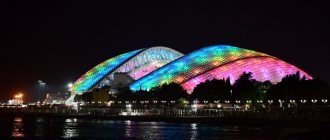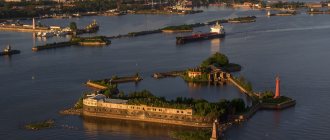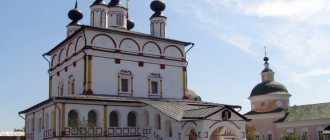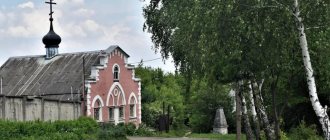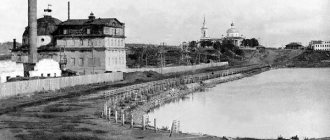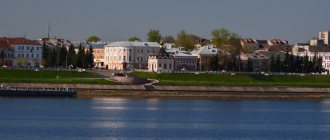Story
The first document confirming patrimonial ownership in the Ivanovo village is considered to be a scribe book of the first half of the 17th century, when it was owned by V. Elchaninov and the Golovin brothers, and then for more than a century it hereditarily belonged to the aristocratic family of Ivan Golovin, until it became the property of Field Marshal Mikhail Fedotovich Kamensky in the middle XVIII century.
It was Golovin who built the first wooden house church of the Ascension of the Lord on the estate, which was also visited by local peasants. The building of the estate's house church fell into disrepair after being destroyed by the French army, and was completely dismantled by the new owners.
Under Tolstoy
By the end of the 18th century, the estate belonged to Count Fyodor Andreevich Tolstoy, privy councilor, senator and passionate bibliophile, great-uncle of the future famous writer.
Having married S.A. Durasova, the rich granddaughter of a Russian gold miner, he begins to improve the estate, creating a landscape park along the river, building a luxurious 2-story estate, erecting a greenhouse and a theater pavilion.
He also intended to build a new stone church on the estate, and even received diocesan permission for this, but due to the shaky financial situation of the count, these plans were not destined to come true.
Under the Zakrevskys
The count's heir becomes Agrafena Fedorovna, married to General Arseny Zakrevsky, a participant in the war with Napoleon and foreign military campaigns, a prominent statesman. After retiring, the general continued to develop the estate, added another floor to the manor house and outbuildings, and moved the house church to the western wing of the house.
Construction on the estate lasted for half a century and included stables that have not survived to this day, a utility yard, many interesting gazebos and small park architecture objects. His wife, one of the first beauties of Moscow and the soul of secular society, organizes magnificent balls and theater seasons at the estate.
The Ivanovo Estate Theater was distinguished by great taste in design and production. Classics and contemporary art were played here, the director and actors of the Maly Theater were invited, amateurs and numerous guests took part in the productions.
A modern exhibition dedicated to the 220th anniversary of her birth is dedicated to the famous mistress of the estate, where you can see numerous portraits of the countess and facts about her turbulent biography. In the middle of the 19th century, the Zakravskys left for Florence, selling the estate to their distant relative Countess Keller.
Today
The next owners of the estate are:
- Countess Sophia Keller, née Bobrinskaya, who bred exotic plants in a greenhouse and supplied her fruit to the imperial table, but was unable to manage the estate for long, ceding it under a deed of sale in payment of a debt;
- Industrialists Bakhrushins from Zaraysk merchants became the last private owners of the estate, setting up a summer residence here, and then transferring the entire estate with an allocation of 200 thousand rubles from charitable capital;
- Moscow city government, which received the estate for free use to establish a children's medical and educational shelter for orphans.
In the post-revolutionary years the estate was used:
- Council of Workers' and Soldiers' Deputies;
- a dormitory for workers from a local factory;
- for communal housing.
In the 60s of the last century, attention was paid to the estate from the point of view of an architectural monument, the complex was taken under state protection, and 10 years later restoration and repair work began. Today, the estate building houses several museum exhibitions on an area of more than 2.3 thousand square meters. m.
What to see in Podolsk
Architectural sights of Podolsk
- The Dubrovitsy estate is an architectural monument of Podolsk; its construction dates back to the 17th century. The main construction work was carried out by Prince Golitsyn, in the Baroque style. The estate is located on the banks of the Pakhra River, framed by a picturesque park.
In the 20th century, the estate housed a museum of noble life, but soon all the exhibitions and furniture were taken out and transferred to Moscow museums, so now there is nothing left inside except for the paintings on the walls from that historical time. Today you can admire the Dubrovitsy Estate only from the outside.
One of the significant historical features of the estate is the Church of the Sign of the Lord, which dates back to the 12th-13th centuries, which you can read in more detail below.
- The Krasnoe estate is located in the vicinity of Podolsk, in the village of Krasnoe. The foundation of the Estate dates back to the 18th century; during its existence, the Estate has seen many owners. The most famous of them were the Saltykov princes, who acquired it in the 19th century. During the reign of which, many additional buildings were adjacent to the Estate. The Red Estate was framed by a luxurious park with ponds.
Today, the church built on the estate has been preserved, which still receives parishioners to this day. The remaining buildings have become very worn out and now the Estate, like the park, is abandoned and fairly overgrown. You can only see the building from the outside and visit the local church.
- The Ivanovskoye estate is located in the village of the same name, near Podolsk. The exact date of construction of the original estate has not been established, however, after it came into the possession of Count Tolstoy, a relative of the writer, significant construction work was carried out on the territory of the Estate. In addition to the main building, outbuildings and a theater were added here.
During Soviet times, the estate was occupied by officials, and later a hostel was located. At the moment, there are 2 museums on the territory of the Ivanoskoye estate, the main building houses the Museum of Vocational Education, and in the wing and garden pavilion there is a branch of the local history museum. A significant role was played by the church built on the territory of the estate, which still operates today.
- The Ostafyevo estate was built in the 18th century and became famous during the ownership of Count Sheremetyev, who was a great connoisseur of literary art. It was Count Sheremetyev who opened the Pushkin Museum on the territory of the estate, which operated until 1930. After a while, some of the exhibits were taken out and sold.
The museum managed to regain its status only after 50 long years; now it houses the thematic exhibition “The Museum We Lost,” and the exhibition “Cabinet of Medals” is located in the outbuilding.
- The Pleshcheyevo estate has changed many owners over its existence, the most popular of them being Fyodor Byakont and P.I. Tchaikovsky. The estate is located on the river bank with an adjacent park.
After the revolution, the buildings were used for various government needs. At the moment, only a few buildings of the estate have survived, which are used as residential buildings for some families.
- The Alexandrovo-Shchapovo estate is located in the village of the same name, near Podolsk. The first memories of the estate date back to the 17th century; at various times it was in the possession of the Morozovs, Grushevskys, and Arsenyevs. Over such a long period of life, the estate was overgrown with a large park with artificially created ponds, a new manor house, a parish school, a school for girls, an almshouse and the Church of the Assumption of the Virgin Mary, famous in the area.
The buildings have not been poorly preserved to this day; they are regularly reconstructed. On the territory of the estate there is now a museum of the history of the estate, a large library and even an organ hall. And the church is still open to all parishioners.
- The Palivanovo estate is located in the vicinity of Pavlovsk. A small village of the same name is located near the Pakhra River, and the estate itself is named after the first owners, the Polivanovs. The construction of the estate dates back to the 17th century, at the same time, a manor park was developed here and a wooden Annunciation Church was erected. After the War of 1812, the church was destroyed and a stone temple was erected in its place. Both the Estate and the Annunciation Church have survived to this day. This area is regularly visited by tourists in order to be transported back to the 17th-18th centuries of our history.
- The Rodnevo estate is a fairly recent building among local estates, dating back to the beginning of the 20th century. The first owners of the estate were a family of local bakers. There are many legends surrounding the building. During Soviet times, the building housed a sports center for Olympic training. Today the building is in dilapidated condition and requires reconstruction.
- The Vorobyovo estate also bears the name of its first owners and is located in a village near Podolsk. The estate was rebuilt under E. Tatishev in the 18th century, and in the 19th century a Temple was erected at the estate in honor of the Descent of the Holy Spirit. In Soviet times, the historical building underwent reconstruction; there was a rest house here; fortunately, nowadays the estate has been restored to its former historical appearance.
- The Slavic Kremlin is an unusual complex built in the Podolsk region in 2005.
This unusual architectural composition personifies the life of the people of ancient Rus'. Here there are buildings in the Old Russian style, ancient mills, stoves, household items and utensils. You can immerse yourself in the era of ancient and medieval history. The complex occupies an area of 2 hectares and is located in the village of Aleksandrovka.
Museums and exhibition halls
- The local history museum is located on the territory of the Ivanovskoye Estate, and every year it expands the number of its exhibits. The discoverers of the museum were local residents in the 70s of the 20th century; they wanted to recreate the history of their native land, and they succeeded very well. The museum moved to Ivanovskoe not so long ago and occupies three large halls. The main exhibition of the museum is the “Podolsk Meridian”, which represents a significant route for local residents that runs through Podolsk and connects Moscow with other provinces.
The exhibitions consist of household items and works of artisans of the 18th-19th centuries, separately highlighted are the works of local artists, as well as artifacts of the 8th-12th centuries found in these lands and reflecting the life of ancient peasants.
- The Podolie Museum-Reserve was opened in the 30s of the 20th century; excursions are held around the territory of the reserve on the site of the Morozov estate. In the Morozov house, there is a museum where exhibitions are located from the time of Lenin, where he stayed more than once. There is also an exhibition dedicated to local residents who lived in Podol in the 18th and 19th centuries. The exhibition includes many exhibits obtained by archaeologists on the territory of the reserve. Here you can get acquainted with the culture of bygone times and stroll through natural landscapes.
- Podolsk exhibition hall is located in the center of Podolsk. It occupies an area of 2000 m and is a modern hall. For holding exhibitions, opening days, galleries, festivals. Similar events have been held here since 1977 to this day. Some of the most popular ones are dedicated to the Great Patriotic War. In the spirit of modernity, the hall is equipped with light and sound equipment, so children's festivals and holidays are often held here.
- The Federal Museum of Vocational Education is located in the Ivanovskoye estate and has been operating here since 1987. The museum tells about the professions that developed in Podolsk during the times of industrial growth, starting from the 18th century, and also includes compositions by local artisans. The total area of the museum is about 3000 meters, where you can see more than 40 thousand exhibits, the number of which is growing every year.
Churches and shrines located in the Podolsk region
- Trinity Cathedral is located on a hill, on Cathedral Square. It was erected at the beginning of the 19th century in honor of the victory over Napoleon. Trinity Cathedral continued to receive parishioners during Soviet times, which gave it an advantage. The main attraction is the presence of the miraculous icon of the Mother of God of Jerusalem near the cathedral, as well as a significant number of particles of the relics of the Saints. Now a Sunday school for children is open at the cathedral, where children are still taught to this day, and the cathedral is still open to parishioners.
- The Church of the Great Martyr George the Victorious is newly built in 2006. A distinctive feature of the church is that it is built of wood, which gives it a medieval spirit. The church also operates a Sunday school where children are educated. The church is consecrated and conducts services for Orthodox parishioners.
- The Znamenskaya Church is located on the territory of the Dubrovitsy estate; it was erected by order of Prince Golitsin at the beginning of the 18th century and is one of the most beautiful churches in Russia. The church is called the pearl of the Moscow region, and Peter 1 himself was present at its baptism.
- The Church of the Resurrection of Christ was considered the most important temple in Podolsk for many centuries. The first wooden temple erected dates back to the 16th century, during the reign of Ivan the Terrible, but over time the building fell into disrepair and it was decided to build a new stone temple in its place in the 18th century.
Since then, the temple has survived 2 wars, destruction, and looting. To restore its former appearance, the Church of the Ascension of the Lord has undergone more than one restoration, and now again rises on a hill and is open to all Orthodox parishioners and tourists.
- Church of the Hieromartyr Nicholas of Podolsk , erected in 2002 in honor of the rector of the Pokrovsky Church, who was shot in 1937 by the Soviet authorities due to perjury. The church is decorated with a five-tiered iconostasis made of gold and a golden dome with a cross. The church holds services and sacraments for its parishioners.
- The Church of the Life-Giving Trinity was built of wood in the 17th century and existed until the 20th century. During Soviet times, the building fell into disrepair and was damaged by fire; most of the icons, thanks to the rector of the temple, were saved. In the 60s of the 20th century, reconstruction began, which lasted 36 long years. The building was restored from stone in the likeness of the previous building. Internal restoration work continued for another 9 long years, and only in 2005 the church was consecrated again and began to receive parishioners.
- The Church of Saints Cyril and Methodius was built not so long ago, in 2012. The temple was built of wood and its style combines medieval and modern architectural traditions. The church has a Sunday school for children, a Church shop, a linguistics and art club dedicated to the Saints, and an educational center for adults.
- The holy spring of Praskeva Pyatnitsa is located in the vicinity of Pavlovsk, in the village of Erino.
According to legend, the icon of Paraskeva Friday disappeared from a local church and was later discovered in the forest. After the icon was returned to the monastery, history repeated itself, and the icon was again found in the same place in the forest. After which the rector of the temple had a dream in which Praskeva Pyatnitsa asked to return her icon to the forest in the same place, since there was a healing spring there. Since then, all local residents have known and revered this source, and visiting tourists strive to get there to collect healing water.
Monuments and monuments of Podolsk and its environs
- The monument to A.S. Pushkin was made of red-brown granite, in the form of a bust, for the bicentenary of the famous poet in 1999. The sculptor engraved a quote from Pushkin’s poems on the pedestal.
- Glory Square was created in the 1970s by a group of architects in honor of the victory in the Great Patriotic War. Two granite walls with bas-reliefs of soldiers were placed on the square and a stele was installed. Over time, the exhibition was supplemented with other monuments.
- The monument to L. Tolstoy was erected on the day of the city of Podolsk, since the writer came to the city more than once, loved to walk along it, his relatives lived here. Lev Nikolaevich is depicted in motion, holding a cloak on one hand and a hat in the other.
- The monument to Catherine 2 is very significant for local residents, because it was she who awarded the village the status of a city. The queen is depicted sitting at a desk, signing a decree granting city status. Symbolically, the monument has been located in Catherine Square since 2008.
- The monument to M.I. Kutuzov was unveiled in the village of Krasnaya Pakhra. In honor of the fact that it was in this area that the military headquarters was located here and a plan for winning the battles was developed. It was opened in honor of the 200th anniversary of the Battle of Borodino in 2012.
- The monument to the Russian Knight was erected in 2000, depicting a knight on horseback in motion. Personifies courage, boldness and bravery of the warriors of this region.
- The monument to the Singer sewing machine was erected in 2011 in honor of the city’s day. The machine, 3.5 m high, is made of bronze on a granite pedestal. A carpet comes out of a working machine, on which a map of the city of Podolsk is depicted. This is a very symbolic monument, because it is in Podolsk that the first American Singer plant is located, which is still operating and developing, producing sewing machines.
- The obelisk monument to the grenadiers of Miloradovich is depicted in the form of a pyramid with four sides, on the top of which is the Alexander coat of arms. In front of the pyramid there are 8 pedestals connected by chains. This monument is dedicated to the grenadiers of Miloradovich, who held the battle for a day, preventing the French soldiers from breaking through to the rear of the army. It was installed in 1912, in honor of the centenary of the battle. However, under Soviet rule, a monument to Karl Marx was erected in its place. But still, in the 90s of the 20th century, the historical monument was returned to its place.
- The sculpture “Podolsk - a city of the working class” is located on the station square. It was installed in 1969, in the form of a working man walking in front. This monument pays tribute to all the workers of this city, over many centuries, who were able to achieve devastating results in the development of industry in the Podolsk region. Because of its location, the sculpture seems to greet everyone entering the city by rail.
- The monument to Podolsk cadets is made of steel and depicts three young people with machine guns, one of whom raised his hand up. The monument was opened in 1975 in honor of the heroes, cadets from two schools who were sent to defend the German approaches to Moscow during the Great Patriotic War. Thanks to them, the Germans never broke through to Moscow, but many cadets died. Local residents come to the city square on Victory Day and beyond to honor the memory of the heroically fallen cadets.
Fountains
- The fountain “Natasha Rostova’s First Ball” is very popular among local residents and tourists; people regularly come here to take pictures and, of course, toss a coin. It was installed not so long ago, in 2014, it is depicted in the form of two dancers - Natasha Rostova and Andrei Bolkonsky. Jets of water create an openwork composition, and evening neon lighting complements the romantic image of the monument, so couples in love often make appointments here.
- The Square of Generations was laid out in 2006 and represents a whole composition. In addition to the fountain, there is also Podolsk “Big Ben” - a clock tower, flower beds, benches and lanterns. The square is a favorite walking place for locals and tourists.
- The Tornado Fountain is a modern light and music fountain-attraction, which has built-in LED spotlights for an evening light show. During the day you can walk along the fountain and cool off on hot days. The fountain's jets can exceed 10 meters, and children especially love to frolic here.
Architecture
The architectural complex of the noble estate was repeatedly reconstructed throughout history and was fully formed only by the middle of the 19th century.
The manor house with 2 symmetrical wings was built in the style of Russian classicism, typical of estate construction of that time.
Estate buildings
The Ivanovskoye estate in Podolsk is a single architectural complex of a majestic central building and utility structures, integrated into the landscape environment of the park area and river landscape. Unfortunately, not all historical buildings have been restored today.
The greenhouse is a dangerous ruin and entering it can be life-threatening. The theater pavilion building is also in ruins.
The estate was connected by an underground passage with a stone grotto; currently the passage is completely blocked and the grotto is destroyed.
The estate complex is surrounded by an Empire style fence with metal bars, completing a single harmonious architectural ensemble of the estate.
Main manor house
The compositional center of the majestic estate is a 3-story mansion of the Old Russian classical style, with a 6-column portico and a triangular pediment above the main entrance, Corinthian loggias and arcades. The openwork wrought-iron spiral staircase on the side of the central entrance has been preserved.
The main facade with a terrace faces the river and is favorably reflected in the water. It was fortified with a stone terrace, now lost. The front facade is completely repeated on the other side of the building, facing the central entrance to the estate. In front of the entrance from the entrance to the estate, a large circular flowerbed was decorated with a fountain installed in the center, decorated with a statue of a woman washing herself.
Today, most of the manor house is occupied by the halls of the museum of vocational education and a branch of local history exhibitions, wedding ceremonies of the visiting registry office are held, festivals, creative evenings and folk celebrations are held.
Outbuilding
The front facade of the building is emphasized by the symmetrical wings of the outbuildings, decorated with Venetian elements of Palladian motifs with semi-columns and wide windows. There are stone passages and covered galleries between the main house and the outbuildings.
The left wing of the estate today is occupied by the exposition of the local history museum. The right wing houses an exhibition of communal rooms of the Soviet past with original furniture and furnishings, a rich archive of photographs and documents, information and historical information about the fate of the families who lived here.
Part of the premises is allocated for the partial reconstruction of the Soviet store, opened in the estate in the middle of the last century.
Manager's house
The flower pavilion or tea house was built at the end of the 18th century. Today, this is the only surviving park pavilion of the estate, occupied by a branch of the local history museum with an exposition of the nature of the region, where you can see stuffed animals living in the area and unique collections of butterflies.
Dubrovitsy after 1917
When the Bolsheviks came to power, the estate was nationalized, and paintings by Russian artists and valuable interior items were removed from it. In 1921, a museum of landowner life was opened in Dubrovitsy; it existed for less than 10 years, and after its closure, the estate was plundered. In 1930, the bell tower of the Church of the Sign was blown up, the main manor house was built on and turned into a dormitory. A fire in 1960 caused significant damage to the historical appearance of the building.
The original appearance of the manor buildings was returned during the reconstruction of 1967–1972, when the Research Institute of Feeding Farm Animals was located in Dubrovitsy along with its own state farm.
Interior of the estate, internal premises
The lobby with Tuscan columns is separated from the main courtyard by an elegant portal. Following the direction of the wide main staircase leading to the right, you can get into the central part of the building, reserved for a spacious stucco hall for balls and receptions.
Inside the Ivanovskoye estate in Podolsk.
There are no ceilings between floors in this part of the room, which adds volume and light to the hall. It is decorated with a ceremonial fireplace in the French style of the Louis XVI era, decorative ceiling paintings, stucco rosettes and a ceremonial chandelier.
Antique wooden parquet has been preserved inside some rooms of the manor house. Everything else is the result of careful restoration carried out under the personal supervision of the director of the Podolsk machine plant A.A. Long since the 90s of the last century.
The concert hall is highly valued by artists for its good acoustics. The estate today regularly hosts professional classical music concerts and performances by local folk groups.
Manor Park
The ancient English-style park was laid out on a high bank around the manor house of the estate, stretched along Pakhra and went down the slope to the water, and was surrounded by a stone fence in the Empire style.
The park alleys were decorated with numerous small architectural forms, and marble sculptures were installed along the main staircase. In front of the manor house there are landscaped parterre terraces; the center of the park is designed in an axial layout along the driveway to the residential complex.
On the territory of the park grow:
- ancient linden trees with a meter-long trunk diameter and a height of more than 20 m;
- smooth elms up to 30 m in height;
- common spruce;
- weeping birches;
- Siberian larches;
- ash-leaved maples;
- poplars;
- horse chestnuts.
Museum opening hours
The Ivanovskoye estate in Podolsk is reserved for exhibitions of 2 museums, which operate according to the following schedule:
| Museum | Days of the week | Working hours | Day off |
| Vocational education | Weekdays | from 10 to 18 o'clock | Monday |
| Saturday and Sunday | from 10 a.m. to 4 p.m. | ||
| Local history | Daily | from 10 to 17 o'clock | Monday |
Cost of visit
You can explore the Ivanovo estate in Podolsk as part of a museum excursion program or on your own. The cost of an individual visit to the main house is 100 rubles. for an adult and 50 rub. for children, students and pensioners.
A tour of the manor house with a guide will cost 50 rubles. expensive. Thematic exhibitions can be viewed for 50-100 rubles; an interactive excursion is offered for 100-200 rubles. You can take photographs or film videos inside the museum complex for an additional fee of 200 to 500 rubles.
Master classes lasting 45 minutes. for a group of 8 to 10 people, they are carried out by agreement by famous local artists and craftsmen at a price of 1.2 thousand rubles.
Merchant tea drinking involves getting to know the historical life of the estate and the life of its owners. Duration of tea drinking from 30 minutes. up to 1 hour. The cost of various format events is about 200 rubles. per person. Various films are shown, exhibitions are discussed, poetry evenings are held, and books are exchanged. All tea parties are by appointment.
In the living room you can purchase memorable souvenirs from your visit to the estate and gift sets of Podolchanka sweets. Ticket sales at the museum box office end half an hour before the complex closes. In the museum you can see exhibitions dedicated to the former owners of the estate, with portraits and items of their everyday life, documents and personal letters, and rare photographs.
A very interesting exhibition is dedicated to the history of the estate. Here are presented rare, unique, authentic household and interior items: a carved wooden sideboard and an oak table that belonged to the last owners of the estate, the Bakhrushins. Much of the previous furnishings were sold or given away by Countess Keller, so the surviving exhibits are especially valuable.
There is a very informative exhibition on the history of vocational education in Russia from the time of Tsar Peter the Great to the present day, where the following are presented:
- unique documentary information;
- cool magazines;
- contracts;
- handwritten textbooks;
- authentic certificates;
- models of educational buildings;
- photos;
- food stamps;
- working model of a robot made from auto parts.
The exhibition of folk art crafts will introduce you to the history of the formation and development of Russian crafts of the region, demonstrating interesting works of local craftsmen from different times: Bogorodsk toys, different types of painting, artistic woodworking and ceramics. There are original exhibits donated to the museum by representatives of different nationalities.
In the premises of the former house church, a chamber exhibition of the history of writing and numbers among the ancient Slavic peoples was opened. It also displays ancient icons, the first alphabet and birch bark notebooks, and engravings depicting a medieval school.
The exhibition, dedicated to the rich theatrical past of the Ivanovskoye estate, presents posters and programs of the first productions and amateur performances, portraits and paintings of actors and performers, copies of archival photographs and dedicatory inscriptions.
The new exhibition is dedicated to the work of 2 original artists of the Rushevs: Nikolai Konstantinovich and his daughter Nadezhda. Here you can get acquainted with the famous graphic illustrations to Pushkiniana, the works of Shakespeare, as well as see photographs and sketches of the theater artist, his portraits. Diary entries, pencil sketches, and personal items are presented.
Parting words for tourists
- Podolsk is a multifaceted city, home to hard workers, art connoisseurs, poets, and industrialists.
- The city united ancient estates and temples under its sky, while not forgetting to expand in terms of population and modern buildings.
- A special merit was the development of mechanical engineering and industry.
- It is important to note that due to its territorial location relative to Moscow - 36 km from the center, many local residents work in Moscow, or visitors rent housing in Podolsk when traveling to the capital for work. Although there is enough work here too.
- The city has excellent transport links; you can easily get to its different areas and see most of the sights in one day.
- From the noisy Capital, and not only, citizens and tourists flock to Podolsk to explore the picturesque natural parks.
- Having been here once, you will definitely want to come back!
How to get to the estate
The Ivanovskoye estate in Podolsk is located on the outskirts of the city, so you will have to go from the railway station to the final stop of bus route No. 4. The cost of the ticket is 43 rubles.
You can get to the city from the capital:
- to the Cinema stop 406, 407 or 415 bus routes departing from the Southern metro station or Lesoparkovaya;
- to the Podolsk railway station by electric train from the Kursk capital station, from the Tekstilshchiki or Tsaritsyno station;
- By car you need to drive along the Warsaw Highway for about 15 km to the Rodina cinema, then turn right onto Mashtakov Street, and then drive along Parkovaya Street to the estate. The coordinates of the estate for the navigator: 55°26′5.42″N (55.434838) and 37°31′17.03″E (37.521396).
Why Podolsk is popular
In the 18th century, a stone bridge was built across the river and traffic through the village increased, and trade routes to Moscow were established. In the same century, by order of Catherine 2, the village was given the status of a city, so the queen is highly revered here and even a monument to her was erected in the city. During the wars of 1812 and 1941, Podolsk had strategic defensive importance for Moscow.
Podolsk is popular both for country holidays for Muscovites and for other tourists. In addition to the advantage of its proximity to the capital, the city has an interesting history and many architectural and historical monuments.
At first glance, Podolsk gives the impression of a gray city, this is true, because we should not forget that this is a highly industrialized part of the region. However, having dug into history and visiting attractions in the form of ancient churches, estates, monuments, fountains, you will see the city for yourself from a different side. Let's consider the main attractions of Podolsk and its surroundings with a detailed description.
Interesting facts, famous inhabitants
Pushkin dedicates his poetic works to the mistress of the house, Agrafena Fedorovna Zakrevskaya, mentioning the brilliant marble beauty in Onegin’s novel. She is also noted in many poems by the poet Evgeny Baratynsky, who fell in love with her. The famous symbolist artist Viktor Borisov-Musatov lived and worked in the estate for some time.
The military-patriotic film “Ilyinsky Frontier”, the film “A Man with a Guarantee”, as well as some scenes of the popular TV series “Molodezhka”, “Web”, “Volnaya Grata” were filmed in Ivanovskoye. The ancient Ivanovskoye estate is undoubtedly a pearl of history and architecture in Podolsk.
But in addition, it attracts with its amazingly rich museum displays and exhibitions, as well as the interesting educational work of enthusiastic employees who hold cultural musical and theatrical events on the estate, attracting not only local citizens, but also residents of the capital.
Personalities
Count Arseny Andreevich Zakrevsky
Count A.A. Zakrevsky , 1785-1865, son of a Tver nobleman, Lieutenant Andrei Ivanovich, born September 15, 1785; was brought up in the Grodno Cadet Corps and, at the age of 19, was released as an ensign in the Arkhangelsk Gorodets Regiment; participated in the campaigns of 1805-1807, where he earned a number of distinctions and was appointed adjutant to the young gr. Kamensky, whose life was saved at Austerlitz. In Moldova, during the assault on Rushchuk, he was shell-shocked in the arm and leg, and for the battle of Batina he received an horde. St. George 4th Art. After the death of Kamensky, he was appointed director of the office of the Minister of War. He took part in the Patriotic War and received St. Vladimir 5th class; On December 5 he was promoted to adjutant wing; for the campaigns of 1815 and 1811 promoted to major general and granted adjutant general on October 8, 1815. From the generals on duty, on August 30, 1825, he was appointed Governor-General of Finland. Emperor Nicholas I appointed him a member of the Supreme Court of the Decembrists, and on April 19, 1828, Minister of Internal Affairs, with the appointment of the Finnish Governor-General. On August 5, 1850, V. Prince was elevated to the title of count. Finnish. When cholera appeared, he was sent with enormous powers to fight it, but these measures did not stop the terrible “cholera-morbus”, and the extreme autocracy of the count caused the displeasure of the Sovereign. On November 19, 1851, Zakrevsky left the service and remained out of work for 17 years. On May 6, 1818, the count was again appointed adjutant general and Moscow military governor-general. After Prince Shcherbatov, Moscow needed to be brought up in view of the ghosts of the revolution and the noticed vacillation of minds... “and the notorious Count Zakrevsky fell on the sleeping city with a rocket from Congreve”; the no less notorious Prince Menshikov said then that Moscow had become “not only a saint, but also a great martyr.” The following year, Zakrevsky was appointed a member of the State Council and received St. Andrew's Star, and Alexander II, on the day of his coronation, granted him his portrait with a gracious rescript. Zakrevsky's dismissal on April 16, 1859 was a complete surprise and followed the fact that his only, spoiled daughter, Count. Lydia Nesselrode from her living husband, with the knowledge of her father, was married to Prince. Drutsky-Sokolinsky and went abroad with a passport illegally given by the Governor General. The Count informed the Tsar only when it was no longer a secret. After leaving the post of Governor General, Zakrevsky lived mostly in Italy and died in Florence on January 11, 1865; buried in his estate, "Galereto", near Florence. Having received the meager education, without any patronage, Zakrevsky owed everything only to himself and often spoke with pride about his “straight path” and the “purity of his intentions.” A. N. Ermolov, gr. Kiselev, Bulgakov brothers, gr. The Vorontsovs were his friends and recognized his outstanding abilities and impeccable honesty; they even found in him a sympathetic heart and a kind soul, for the majority, however, somewhere deeply hidden under an icy shell; even his ill-wishers considered him a far from ordinary person. Alien to any liberal tendencies, with his common sense he clearly saw the shortcomings of the reality around him, and he cannot be denied an understanding of political events; He had a particularly negative attitude towards the activities of Arakcheev, whom he called “a plague”, “a snake” and “the only state villain”. But arrogance, harshness and inaccessibility brought him closer to this hated temporary worker, and he was loved by few people, although he himself did not notice it. In Moscow, where he arrived at the end of his days, Zakrevsky insisted that he “needed to be stern in appearance,” and was seriously convinced that ruling the capital was only “patriarchal,” in its spirit, being a defender of the right and a threat to everyone evil; however, thanks to the heavy guardianship over the townsfolk, administrative arbitrariness and the espionage system, for the majority Zakrevsky was a capricious and suspicious despot who put his will outside the law, while still being accessible to outside influence, starting with his frivolous daughter and ending with his valet, the famous Matvey. A man of unyielding will and iron character, the formidable count, before whom everything trembled, succumbed to the onslaught of his family and appeared helplessly weak before the whims of his beloved, kind, but whimsical wife, Count. Agrafena Fedorovna, who caused him quite a lot of grief as a person and as a spouse.
(Portrait of Count A.A. Zakrevsky. 1820 I. Sergiev (I. Sergeev?))
Countess Agrafena Fedorovna Zakrevskaya
1. Countess A.F. Zakrevskaya , 1800-1879, daughter of gr. Fyodor Andreevich Tolstoy, married to Stepanida Alekseevna Durasova, granddaughter of the rich man Myasnikov. The only child in the family, the favorite of her Old Believer grandmother, “Grushenka” was spoiled by an eccentric father who could “set an example for all sorts of nonsense,” and she herself madly loved her mother, who came from an environment of complete darkness and superstition. Her childhood passed amid complete idleness; as a beautiful girl, she fluttered around the balls with her rejuvenating father. A passionate lover of French novels, with which she spent all her free time, in moments of grief she crossed herself in the schismatic style with “two fingers.” A split will made her unbalanced: infinitely kind, seemingly capricious, a “flighty laugher,” she, “a slave to a tormenting dream,” suffered “in the anguish of spiritual emptiness,” and her “convulsive joy” quickly turned into hysterical sobs. “Like Magdalene, you cry, and like a mermaid, you laugh”! Baratynsky wrote about her. On September 27, 1818, she married the 35-year-old dry pedant Zakrevsky and did not bring “peace and prosperity” to his house. After 5 years, carried away by “her dreary dream,” she went abroad for treatment, and they did not expect her to return. “I heard,” wrote Bulgakov, “that at a ball in Florence, Coburg announced that he could not go with her to Livorno; she fainted and had a regular seizure"; but several days passed and she returned: “You can imagine Zakrevsky’s joy: A.F. is fresh as a rose, somewhat kinder, very cheerful and happy to be here. The same kind of flightiness, talking about 10 subjects at one time”... In Finland, she gave favor to young people who were with her husband, but Count enjoyed her special favor. Armfeld. On July 18, 1820, her only daughter Lydia was born. Her hobbies continued and were as frequent as her disappointments were quick; She made Pushkin her “confidant,” and he, “burning with the flame of love, with his head down, jealously,” listened to her “confession” and wrote: “But stop your stories; hide, hide your dreams: I’m afraid of their fiery infection, I’m afraid to find out what you knew!” The poet envied the lucky man, “with whom you are clearly in love, whose gaze dominates you,” and this “lucky man” (in 1828) was another poet, Baratynsky; enchanted by her charming beauty, caught in her “magic net,” he sang of the insane laughter of his “mermaid”:
How much you have lived and felt in just a few days! In the rebellious flame of passions, how passionately you burned out!
2. 20 years passed in Moscow, and evil tongues still surrounded her; Here, too, she gathered young people around her, who owed their career successes with the count to her patronage; the most risky adventures were attributed to her; she was “not embarrassed by anything.” Moscow had fun at balls and performances at her dacha (Studenets) and in Ivanovsky, Podolsk district, but her evenings in Moscow were not successful: “strict Moscow ladies shied away from her company,” which, however, did not upset her much: she always “ she loved only the company of men and did not know how to talk to ladies.” “Delicate with inferiors, affectionate with everyone, valuing every service dearly, she did not know how to refuse requests and could not see tears; the predominant feature of her character was kindness, reaching the point of weakness.” She generously gave charity, but indiscriminately; she wanted to help everyone, but often to the detriment of justice; she was perfectly in place next to the inaccessible and formidable count and saved many; Even the Old Believers, who were persecuted at that time, thanks to her, found in Zakrevskoye an intercessor before Filaret himself. After the death of her husband, Zakrevskaya lived in the summer in Livorno, and the rest of the year in Florence, where she died in the winter of 1879. She was buried in the tomb next to her husband. Not stupid by nature, who subordinated people of outstanding intelligence and strong character to her weak will, Zakrevskaya had major shortcomings, which were redeemed by the high qualities of her heart. Pushkin successfully sketched her “portrait” with a few elegant strokes:
With her flaming soul, with her stormy passions, Oh, wives of the North, she sometimes appears among you, And strives past all the conditions of the world until she loses strength, - Like a lawless comet in the circle of calculated luminaries.
( 1. Portrait of Count A.F. Zakrevskaya. 1810s. Unknown artist; 2. From a miniature belonging to Count D.I. Tolstoy, in St. Petersburg)
